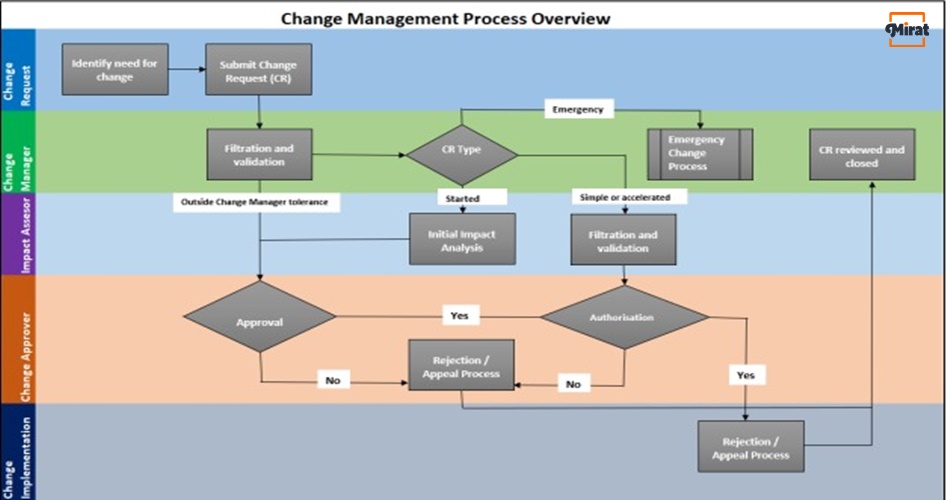A procedure of IT Service Management, the aim of IT Change Management is to make things simpler for an organization to introduce alteration requests to its IT ecosystem. By using it, an organization can request, rank, sanction, allow, plan and deploy conversions anywhere in its infrastructure. A capable IT Change Management method can help companies reduce drastically the risks and minimize troubles to as few as possible. Here, it does not matter if a swap is complicated or simple.
Protection of Services
Transposition-affected IT services can either be visionary or reflexive. For instance, if an organization wants to add a new process to improve its productivity, it implements proactive conversions to provide new services or products. By doing so, it improves its services by cutting costs or enhancing efficiency. Reactive switches are those deployed when a firm’s security may be compromised, or it needs to fix its servers to prevent minimal damage so that its efficiency would not be impacted.
If a firm wants to introduce a new path-breaking product or service across the board, it would be better if it adopted modification- and Release Management to make this practice seamless and highly productive. It is important to use such an approach as any alteration to its framework may cause glitches or other issues, leading to hindrances in its services. For instance, it could cause downtime to its systems and decrease the efficiency of its personnel at the service desk. It could lead to many other adverse events if the change management IT is not implemented properly.
If performed properly, IT Change Management protects an organization’s services from any of these needless blunders. Even if it has goofed up, the software ensures that the organization is able to easily track all revisions and determine exactly where things went awry.
IT Change Management’s Advantages
Besides reducing flaws in the services of a company, well thought change management system brings along with it many gains.
It allows organizations to usher in revises more swiftly, monitors the improvements of variations to its IT infrastructure, enables to make more transparent the process of its Change Management IT, bettering its interactions with stakeholders, tracking seamlessly the introduction of substitutions in case it was carried out improperly and better its cost assessment for any modifications planned.
The Different Types of Changes
There are three different types of transformations in IT Change management software. They can be broadly classified into amendments that are standard, normal, and emergency. Each of these categories of adaptations has to be handled differently.
- Standard revisions are modifications made to services or to the IT setup. The process of deployment and risks they bring with them are known here beforehand. It could either be an introduction of a new computer peripheral or a new software package.
- Normal alterations involve those amendments that a swap procedure needs to be subjected to before they are ready for a go-ahead and deployment. Included in such transformations are transitioning a new expansion project to production or an addition of a new device.
- Reformations that can be considered emergencies are those that need to be carried out immediately.
What Exactly Is Involved In The IT Change Management Procedure?

When the best practices of a Change Management framework are initiated, it means all modifications to an IT ecosystem are evaluated, sanctioned, deployed, and thoroughly checked in a regulated manner. In order to perform so, an organization has to adhere to various Change Management tools. The following are included in it.
RfC – a formal request for a change, assessing any revisions requested, coming up with a comprehensive project plan to introduce modifications, reassessing and fine-tuning a plan – usually performed by the stakeholders, devising or finalizing the timelines for carrying out the shift, trying out the adaptation and evaluating and documenting the outcomes of the variation implemented.
How To Distinguish A Change From An Incident Or An Issue?
While a replacement is an act performed to improve vastly the IT service department of an organization without impacting its activities too much. On the other hand, incidents or issues fall under another purview.
An incident can be described as a single issue that causes all organization’s services to be not performing as they should. If a PC is not functioning properly, it could be categorized as an incident. Issues or problems would include chronic disruptions that harmfully affect an entire company’s IT infrastructure.
Why Is Change Management Associated With ITIL?
In the Information Technology Infrastructure Library (ITIL) structure, the Service Transition life cycle stage is a component of Change- and Release Management. It, in fact, constitutes one of the five stages of the life-cycle of the ITIL fabric. Service Transitions are critical as they aid an organization in plotting and managing the replacement of a service’s status in its life cycle.
MIRAT’s Best Practices For Managing An IT Service Department
In the current service environment, if you want to successfully complete your company’s service delivery, remember that it is defined by the satisfaction your customer derives from it. In a scenario when most IT models still concentrate on devices and procedures, isn’t it sometimes tough to please customers? If you are currently facing such issues, Mirat’s best practices can help you resolve them.
Mirat.ai’s IT Infrastructure Management is Affordable & Easy to use! Get your Dashboard ready in only 5 Minutes. Request for Trial/Demo now (or) Contact our Team Now .
Contact Information:
Hema
Sales Executive
Phone: +1-315-636-4213
Email: sales@mirat.ai
Website: https://www.mirat.ai/

